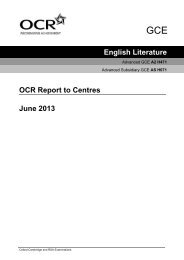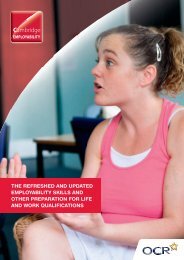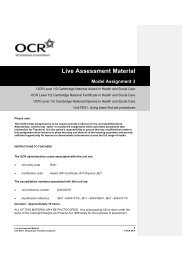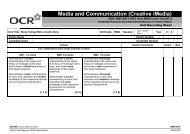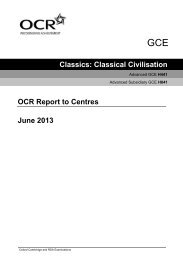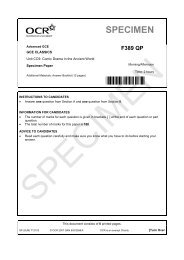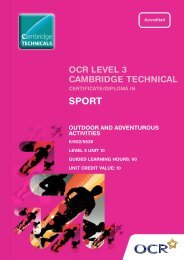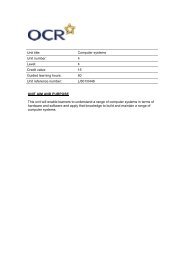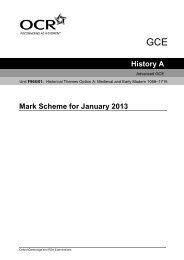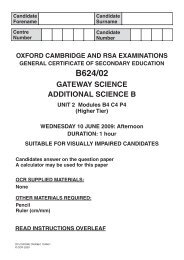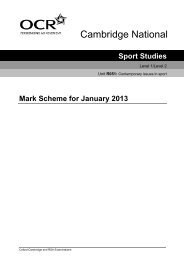Medical word processing - OCR
Medical word processing - OCR
Medical word processing - OCR
Create successful ePaper yourself
Turn your PDF publications into a flip-book with our unique Google optimized e-Paper software.
TEXT PROCESSING<br />
(BUSINESS PROFESSIONAL)<br />
<strong>Medical</strong> Word Processing<br />
Level: 2 06996<br />
Credits: 5<br />
Learning Time: 50 hours<br />
Learning Outcomes<br />
The learner will …<br />
1 Be able to use a<br />
<strong>word</strong> processor<br />
Assessment Criteria<br />
The learner can …<br />
1.1 Select and use the functions<br />
of a <strong>word</strong> processor,<br />
including<br />
- open files<br />
- save files<br />
- setting and adjusting<br />
margins<br />
- line spacing<br />
- alignment including left and<br />
centre alignment, tab<br />
alignment, decimal<br />
alignment of numbers and<br />
money and full justification<br />
- change font style and size<br />
- indenting text<br />
- cut, coy and paste<br />
- pagination<br />
- headers/footers<br />
- page numbering<br />
- find and replace<br />
- sorting data<br />
- ways of emphasising text<br />
- underlining text<br />
- format for portrait or<br />
landscape<br />
- insert, position and<br />
manipulate a picture<br />
- wrapping text<br />
- create tables<br />
- recalling AutoText phrases<br />
- perform a <strong>word</strong> count<br />
- inserting automatic<br />
filename and path<br />
- spell checking<br />
- printing<br />
Knowledge, understanding and<br />
skills<br />
• Retrieve pre-stored documents,<br />
retaining font style and size<br />
• Set margins of at least 13 mm<br />
• Adjust left and top margins<br />
• Change line spacing to<br />
double/single<br />
• Left alignment, including main<br />
and subheadings as presented<br />
in the draft<br />
• Alignment of decimal points<br />
• Centre text<br />
• Change text to full justification<br />
• Emphasise text, using bold,<br />
italics, underlining, change of<br />
font style/size only<br />
• Inset text from the left margin<br />
• Move and copy text<br />
• Insert page breaks<br />
• Insert a header or footer, in<br />
specified position<br />
• Insert and control page<br />
numbers<br />
• Search and replace<br />
• Underline <strong>word</strong>s which will be<br />
included in handwritten text in<br />
the draft<br />
• Create a table, adjust column<br />
widths, merge cells and remove<br />
borders<br />
• Insert a specified image, adjust<br />
width and set text wrapping<br />
• Sort data alphabetically,<br />
numerically or chronologically<br />
• Insert an automatic filename<br />
and path in the footer area<br />
• Recall pre-stored AutoText<br />
phrases<br />
1<br />
<strong>Medical</strong> Word Processing Level 2 (06996) © <strong>OCR</strong> 2011 Oxford Cambridge and RSA Examinations
Learning Outcomes<br />
The learner will …<br />
2 Be able to key in<br />
text with a<br />
medical context<br />
from handwritten<br />
and typewritten<br />
drafts<br />
3 Be able to<br />
interpret implied<br />
and explicit<br />
instructions<br />
Assessment Criteria<br />
The learner can …<br />
2.1 Key in text, including<br />
- capitalisation<br />
- punctuation<br />
2.2 Key in text to a specified layout<br />
including<br />
- multi-page report, article,<br />
information sheet<br />
- notice, poster,<br />
advertisement<br />
- document containing a table<br />
- medical letter inserting<br />
AutoText phrases<br />
2.3 Key in a table consistently from<br />
handwritten draft, including<br />
adjusting column widths and<br />
merging cells<br />
3.1 Complete work within set<br />
timescales<br />
3.2 Retrieve pre-stored documents<br />
or templates<br />
3.3 Use consistent style and<br />
presentation, including<br />
- clear line space before and<br />
after separate items in<br />
documents<br />
- display of date,<br />
measurement, weight, time,<br />
money, figures, dashes and<br />
hyphens<br />
- retain font style and size of<br />
recalled text<br />
3.4 Comply with instructions for<br />
amending medical documents,<br />
including<br />
Knowledge, understanding and<br />
skills<br />
• Use <strong>word</strong> count facility<br />
• Format document for landscape<br />
printing<br />
• Print single and multi-page<br />
documents,<br />
• Producing additional copies and<br />
indicate routing.<br />
• Read and transcribe variable<br />
quality manuscript<br />
• English spelling, punctuation<br />
and grammar and medical<br />
terminology<br />
• Key in a three-column unruled<br />
table with one sub-divided<br />
column and multi-line headings<br />
• Column headings and data in<br />
columns must be consistently<br />
aligned to the left<br />
• Align decimal points with the<br />
longest figure left aligned with<br />
the column heading<br />
• Present text in the table as<br />
shown on the draft, adjusting<br />
column widths and merging<br />
cells to prevent <strong>word</strong> wrap<br />
• Use conventional layout and<br />
style for business documents.<br />
• Letter<br />
- Our ref details are keyed in<br />
as draft, including<br />
capitalisation and<br />
punctuation<br />
• Use appropriate stationery<br />
• Retrieve pre-stored files and<br />
amend text as shown in the<br />
draft, maintaining existing font<br />
style and size<br />
• Modify the table, eg change<br />
sequence of columns or change<br />
the order of sections<br />
• Allocate vertical space of a<br />
specified size<br />
2<br />
<strong>Medical</strong> Word Processing Level 2 (06996) © <strong>OCR</strong> 2011 Oxford Cambridge and RSA Examinations
Learning Outcomes<br />
The learner will …<br />
new paragraph or<br />
run on<br />
Assessment Criteria<br />
The learner can …<br />
- modify the layout of the<br />
table<br />
- allocate vertical spacing<br />
- insert, position and<br />
manipulate a picture<br />
3.5 Comply with instructions for<br />
production of medical letters,<br />
including<br />
- inserting today’s date<br />
- retrieving AutoText phrases<br />
- inserting destination details<br />
- producing extra copies<br />
- indicating routing<br />
- use specified font style and<br />
size<br />
3.6 Make amendments to text as<br />
shown in the draft<br />
insertion with <strong>word</strong>(s) above or balloon with arrow eg<br />
transpose horizontally or balloon with arrow eg<br />
transpose vertically<br />
transpose consecutive items vertically<br />
close up<br />
leave a space<br />
stet with in margin<br />
4 Be able to check<br />
documents for<br />
accuracy<br />
5.1 Check documents for<br />
accuracy, correcting mistakes<br />
as necessary<br />
Knowledge, understanding and<br />
skills<br />
• Letter<br />
- Insert today’s date<br />
- Use specified font and size<br />
ensuring consistency<br />
- Recall two AutoText<br />
phrases<br />
- Produce extra copies and<br />
indicate routing of copies.<br />
- Number continuation<br />
sheets<br />
• Amend text as shown in draft:<br />
- deletion with replacement<br />
<strong>word</strong>s<br />
- deletion without<br />
replacement <strong>word</strong>s<br />
- follow correction signs:<br />
no marginal<br />
instructions<br />
• Use of spellchecker<br />
• English spelling, punctuation<br />
and grammar<br />
• <strong>Medical</strong> and drug dictionaries<br />
• Proofreading skills<br />
• Use appropriate correction<br />
techniques to ensure work is<br />
accurate<br />
3<br />
<strong>Medical</strong> Word Processing Level 2 (06996) © <strong>OCR</strong> 2011 Oxford Cambridge and RSA Examinations
Unit aim<br />
This unit aims to equip candidates with the ability to produce, from handwritten and recalled text<br />
using a <strong>word</strong> processor, a variety of routine medical business documents to a standard that meets<br />
the requirements of employment. They demonstrate understanding of the requirements of medical<br />
conventions.<br />
Assessment<br />
Assessment will consist of producing four business documents with a medical context totalling no<br />
more than 1,040 <strong>word</strong>s (500 <strong>word</strong>s to be input by candidates and no more than 540 recalled<br />
<strong>word</strong>s) and will take the form of a 1 hour 45 minute test set and marked by <strong>OCR</strong>.<br />
Results will be graded Distinction, Pass or Fail.<br />
To achieve a Distinction, candidates must produce the documents with no more than 4 faults within<br />
the time allowed (1 hour 45 minutes).<br />
To achieve a Pass, candidates must produce the documents with no more than 11 faults within the<br />
time allowed (1 hour 45 minutes).<br />
The grade achieved will be stated on the certificate.<br />
Administration guidance<br />
• A <strong>word</strong> processor must be used to complete the examination<br />
• Centres must ensure that the recall material for this examination is available for candidates.<br />
Recall material is supplied for each examination by <strong>OCR</strong> publications on CD-ROM or can be<br />
downloaded free of charge from Interchange, <strong>OCR</strong>’s secure website<br />
• Centres must not re-key or amend the pre-stored documents, or letterhead. Centres must<br />
check that the AutoText phrases work on their system and if necessary key in the AutoText<br />
phrases in the letterhead template file<br />
• Stationery: A4 plain paper will be required<br />
• Printing: Candidates must carry out their own printing. No changes whatsoever may be<br />
made to the documents outside the time allowed for the examination. Printing may be<br />
undertaken in a period immediately following the examination and supervised by the<br />
Invigilator<br />
• For further information regarding administration for this qualification, please refer to the <strong>OCR</strong><br />
document Admin Guide for Vocational Qualifications (A850).<br />
Guidance on assessment and evidence requirements<br />
For detailed guidance, please refer to the marking criteria and tutor notes in this document.<br />
Candidates must produce four medical business documents to a standard acceptable in the<br />
workplace and outcomes must be within the permitted error tolerance.<br />
Penalties are given for errors and the same fault appearing more than once will incur a penalty<br />
each time. One fault only will be given to any one <strong>word</strong>* irrespective of the number of errors that<br />
may appear in that <strong>word</strong>. For example, “miscellaneous” keyed in as “miss-selanious” will be<br />
penalised 1 fault, even though several faults have been incurred in the <strong>word</strong>. Presentation<br />
(Section 4) faults may also be applied.<br />
4<br />
<strong>Medical</strong> Word Processing Level 2 (06996) © <strong>OCR</strong> 2011 Oxford Cambridge and RSA Examinations
* A <strong>word</strong> is defined as any normally recognisable <strong>word</strong> including a hyphenated <strong>word</strong> and<br />
associated punctuation and spacing. Other items that are treated as a <strong>word</strong> are:<br />
• postcode<br />
• initials and courtesy titles<br />
• simple or complex numbers including money, times and telephone numbers<br />
• simple or compound measurements<br />
Invigilators are given clear instructions to report any problems with printers, failure to do so can<br />
disadvantage candidates.<br />
You should refer to the <strong>OCR</strong> Admin Guide to Vocational Qualifications (A850) for Notes on<br />
Preventing Computer-Assisted Malpractice.<br />
Errors will be divided into 4 categories:<br />
Marking Criteria Tutor Notes<br />
Section 1 Faults - keying in errors<br />
One fault will be given for each <strong>word</strong>* which:<br />
1.1 contains a character which is<br />
incorrect (including upper case<br />
character within a <strong>word</strong>), or is<br />
illegible for any reason<br />
1.2 has omitted or additional characters<br />
or spaces<br />
1.3 contains handwritten character(s)<br />
1.4 has no space following it<br />
1.5 has more than 2 character spaces<br />
following it, except where<br />
appropriate, eg before postcode,<br />
after punctuation<br />
• A penalty will be incurred for any <strong>word</strong> that contains a<br />
character that is incorrect or that includes an upper<br />
case character within a <strong>word</strong>, eg laBel<br />
• Candidates may use English, mother tongue, medical<br />
and drug dictionaries and spellcheckers where<br />
available<br />
• A space inserted between a <strong>word</strong> and its associated<br />
punctuation, eg <strong>word</strong> : or <strong>word</strong> ? will incur 1 fault per<br />
instance<br />
• Incorrect or omitted paired punctuation eg brackets,<br />
single quotes will incur 1 fault per ‘pair’, eg ( Progress<br />
Group ), ‘ Progress Group ’<br />
In continuous text, 1 fault per instance will be incurred<br />
for:<br />
• more than 3 spaces appearing after a full stop,<br />
question mark, exclamation mark or colon<br />
• more than 2 spaces appearing after a comma, semicolon,<br />
closing bracket, dash, apostrophe (at the end<br />
of a <strong>word</strong>) and closing single or double quotes<br />
• where a short line appears, this will be penalised if<br />
the first <strong>word</strong> following could have fitted at the end of<br />
the short line with at least 18 mm (¾”) to spare<br />
(measuring the short line against the longest line in<br />
the document)<br />
NB: No penalty will be incurred for inconsistency after<br />
punctuation eg 1 or 2 spaces inconsistently after a full<br />
stop<br />
5<br />
<strong>Medical</strong> Word Processing Level 2 (06996) © <strong>OCR</strong> 2011 Oxford Cambridge and RSA Examinations
Marking Criteria Tutor Notes<br />
1.6 contains overtyping, including<br />
overtyping of pre-printed material<br />
(per entry regardless of the number<br />
of <strong>word</strong>s involved) eg letterheads<br />
1.7 does not contain initial capitals as<br />
presented in the draft, including the<br />
first letter of a sentence and the first<br />
letter of a row of text in a table<br />
Section 2 Faults – omissions and additions<br />
One fault will be given for:<br />
2.1 each <strong>word</strong> which is the wrong <strong>word</strong><br />
and a <strong>word</strong> that has been omitted<br />
or added or not removed as<br />
instructed (eg a <strong>word</strong> which is<br />
crossed out in the draft)<br />
• Candidates should key in text as presented in the<br />
draft. One fault per instance will be incurred for each<br />
initial capital drafted that has been keyed in as a<br />
lower case character (this includes faults in drug<br />
brand names and diseases named after a person eg<br />
Hodgkin’s Disease)<br />
• Failure to insert a capital letter following a penalty for<br />
an omitted full stop will not be penalised.<br />
• Inserting a capital letter following a penalty for an<br />
incorrect full stop will not be penalised<br />
• Failure to delete recalled text and insert replacement<br />
<strong>word</strong>s will incur 1 fault for each <strong>word</strong> that has been<br />
omitted or is the wrong <strong>word</strong><br />
• The unspecified deletion and/or duplication of<br />
recalled text will incur 1 fault per <strong>word</strong>, unless it can<br />
be attributed to a vertical or horizontal transposition,<br />
deletion without replacement (see 2.2 below), move<br />
or copy<br />
• If items to be vertically transposed include an<br />
amendment to text (eg deletion with replacement<br />
<strong>word</strong>s) or a correction sign for insertion of <strong>word</strong>s (eg<br />
caret sign, balloon or “stet”), 1 fault per <strong>word</strong> for<br />
wrong/omitted <strong>word</strong>s will be incurred under 2.1, in<br />
addition to any penalty under 3.1<br />
• One fault will be incurred for each instance of a<br />
missing, incomplete or incorrect date to be inserted<br />
on correspondence as instructed on the front cover of<br />
the question paper<br />
• All errors in other dates are penalised per element<br />
• The date must appear below the letterhead and<br />
above the salutation of the letter and should have a<br />
clear line space above/below<br />
• Any style of date is acceptable, with the exception of<br />
the American numeric format, eg 12/25/2011 as<br />
Christmas Day<br />
• In the medical letter, any presentation of DOB and<br />
the patient’s actual date of birth in the subject<br />
heading is acceptable. The <strong>word</strong> Re or Ref will be<br />
accepted as part of the heading<br />
• If a date appears in a document that does not require<br />
dating, this will be penalised 1 fault maximum unless<br />
the date appears as part of the personal details or<br />
above the first line of the document or below the last<br />
line of the document<br />
6<br />
<strong>Medical</strong> Word Processing Level 2 (06996) © <strong>OCR</strong> 2011 Oxford Cambridge and RSA Examinations
Marking Criteria Tutor Notes<br />
2.2 each instance of failure to:<br />
− delete recalled text as instructed<br />
− produce an extra copy<br />
2.3 omission of implied or explicit<br />
instructions (regardless of the<br />
number of <strong>word</strong>s involved) for<br />
failure to:<br />
− insert each AutoText phrase<br />
− insert headers or footer as<br />
instructed<br />
− use specified font style/size<br />
− ensure consistent use of font<br />
style/size throughout a<br />
document<br />
− insert number pages as<br />
specified<br />
− insert page breaks as<br />
instructed<br />
− carry out an aspect of<br />
modification as instructed<br />
− insert a picture<br />
− resize picture<br />
− wrap text left/right of picture<br />
− underline text<br />
− indicate destination details on<br />
all copies<br />
− indicate routing<br />
− use software facilities to<br />
perform a <strong>word</strong> count<br />
− insert an automatic filename<br />
and path in the footer area<br />
− present text in the table as<br />
shown on the draft<br />
− merge cells over sub-divided<br />
columns<br />
• Candidates will incur a fault if they set up their own<br />
reference or omit the reference or add their own<br />
initials<br />
• Our reference details must be keyed in as shown in<br />
the draft, including capitalisation and punctuation (do<br />
not expand ref). Treat the whole reference as 1 unit<br />
for marking purposes. Errors in references incur 1<br />
fault maximum per document.<br />
• Failure to type correct <strong>word</strong>s in accordance with the<br />
stet correction sign.<br />
• Failure to delete recalled text as shown in the draft<br />
will incur 1 fault maximum, irrespective of the number<br />
of <strong>word</strong>s involved (this relates to a deletion where<br />
there are no replacement <strong>word</strong>s written above the<br />
<strong>word</strong>s crossed through)<br />
• Penalise 1 fault for each copy not produced<br />
• Changes made to the font style/size in a document<br />
where there is no instruction to do so will incur 1 fault<br />
maximum per examination paper<br />
• Failure to use a specified font style/size as instructed<br />
will incur 1 fault maximum per document<br />
• Documents must be saved using filenames as<br />
instructed prior to printing<br />
• Failure to insert the phrase in full or duplication of<br />
any part of a phrase will be penalised as 1 fault per<br />
phrase<br />
• Failure to insert a header/footer in the specified<br />
position as instructed incurs 1 fault maximum<br />
(including keying errors). Capitalisation faults may<br />
also be penalised under 4J (see below)<br />
• Headers/footers may appear within the top/bottom<br />
margins<br />
• Any font style and size may be used in the<br />
header/footer area<br />
• Page Numbers: errors and omissions related to page<br />
numbers are penalised as 1 fault maximum per<br />
examination paper including:<br />
- failure to insert page numbers as instructed<br />
- insertion of page numbers on single-page<br />
documents<br />
- page numbers not inserted on continuation<br />
sheets<br />
• Page numbers may appear in any position and may<br />
be any style but must appear once only on each<br />
page of a document<br />
• Failure to insert page breaks where instructed in the<br />
multi-page document will incur 1 fault maximum<br />
• Failure to carry out an aspect of modification,<br />
ie change the sequence of columns in a table, will<br />
incur 1 fault<br />
7<br />
<strong>Medical</strong> Word Processing Level 2 (06996) © <strong>OCR</strong> 2011 Oxford Cambridge and RSA Examinations
Marking Criteria Tutor Notes<br />
• Failure to carry out the find and replace or errors in<br />
the replaced text will incur 1 fault. The <strong>word</strong> used in<br />
find and replace will be keyed in consistently, eg<br />
SHARE, Share, share<br />
• Failure to insert and manipulate the correct picture as<br />
instructed will incur 3 faults maximum – 1 each for<br />
failure to insert, size and wrap as instructed.<br />
Measurement of the picture must be accurate within<br />
a 1 mm tolerance<br />
• Failure to underline <strong>word</strong>s within the text exactly as<br />
shown in the draft incurs 1 fault maximum, including<br />
omission of the underline and underlining which is<br />
too long or too short (this is not treated as<br />
presentation which relates to the underlining of<br />
headings – see 4J below)<br />
• The destination and routing:<br />
- destination details must include the <strong>word</strong> “copy”,<br />
“cc” or similar (1 fault)<br />
- destination details must appear on all copies. In<br />
addition, candidates may include “file” or “files”<br />
as a destination on all, or just the file copy<br />
- addressee’s name included in destination details,<br />
1 fault maximum will be incurred<br />
- routing must be indicated on at least one copy<br />
- any method of indication of routing will be<br />
accepted eg tick, underline, highlighting on<br />
appropriate copy<br />
- errors, omissions etc relating to extra copies,<br />
destination details and routing will be penalised<br />
as 2 faults maximum<br />
• The <strong>word</strong> count will be evidenced by candidates<br />
keying in the figure below the final line of text<br />
• An incorrect <strong>word</strong> count will incur 1 fault maximum<br />
• An incorrect <strong>word</strong> count resulting from errors in the<br />
text will not be penalised<br />
• Table column widths must be adjusted so data is<br />
displayed on one line as shown on the draft –<br />
wrapped text will incur 1 fault maximum<br />
• Column headings must be presented exactly as<br />
shown on the draft<br />
• Merge cells to ensure heading over two sub-divided<br />
columns and section headings are displayed on one<br />
line as shown on the draft – wrapped headings will<br />
incur 1 fault maximum.<br />
• Failure to remove gridlines will incur 1 fault<br />
• Both the automatic filename and path must be clearly<br />
shown in the footer area using the specified save<br />
filename; otherwise 1 fault maximum will be incurred<br />
8<br />
<strong>Medical</strong> Word Processing Level 2 (06996) © <strong>OCR</strong> 2011 Oxford Cambridge and RSA Examinations
Marking Criteria Tutor Notes<br />
Section 3 Faults - transpositions and misplacements<br />
One fault will be given for each instance of:<br />
3.1 items not transposed (horizontally<br />
or vertically) in accordance with a<br />
correction sign<br />
3.2 <strong>word</strong>s that are misplaced within<br />
text, where there is no instruction<br />
regardless of the amount of <strong>word</strong>s<br />
involved<br />
3.3 failure to paragraph as per draft or<br />
as specified by a correction sign,<br />
eg new paragraph or run on<br />
3.4 a list of items not sorted as<br />
instructed<br />
• Failure to transpose items in recalled text<br />
(horizontally or vertically) in accordance with a<br />
correction sign will incur 1 fault per correction sign<br />
• Omitted or additional text resulting from an attempt at<br />
vertical or horizontal transposition of recalled text will<br />
be penalised 1 fault maximum<br />
• Failure to sort as instructed will incur 1 fault per<br />
document. Any omitted, additional or incorrect <strong>word</strong>s<br />
will be penalised 1 fault per <strong>word</strong> under 2.1<br />
• Failure to ensure that corresponding details are<br />
correctly rearranged in the table sort will incur 1 fault<br />
maximum<br />
3.5 failure to copy text as instructed • Failure to copy text within a document as instructed<br />
will be penalised 1 fault maximum<br />
• Copying the wrong text will be penalised 1 fault<br />
maximum<br />
• Moving the text rather than copying text will be<br />
penalised 1 fault maximum<br />
3.6 failure to move text as instructed • Failure to move text as instructed will be penalised<br />
1 fault maximum<br />
• Moving the wrong text will be penalised 1 fault<br />
maximum<br />
• Copying text rather than moving text will be penalised<br />
1 fault maximum<br />
• If all or part of the text to be moved is duplicated or<br />
missing, 1 fault maximum will be penalised<br />
Section 4 Faults – presentation<br />
No more than one fault per paper for each of the following items:<br />
4A left and/or top margins of less than<br />
13 mm, or ragged left margin<br />
• Ragged left margin, eg additional character spacing<br />
at the beginning of a line or paragraph<br />
• Main and subheadings not keyed in at the left<br />
margin, as presented in draft – unless otherwise<br />
instructed (eg centring) or recalled<br />
• Section headings in table must appear as draft<br />
• The table may be inset from left margin but if table<br />
extends into the left margin resulting in an irregular<br />
left margin with text above/below table a fault will be<br />
incurred<br />
9<br />
<strong>Medical</strong> Word Processing Level 2 (06996) © <strong>OCR</strong> 2011 Oxford Cambridge and RSA Examinations
Marking Criteria Tutor Notes<br />
4B no clear line space before and after<br />
separate items within a document<br />
4C failure to use line spacing as<br />
instructed<br />
4D failure to emphasise text as<br />
instructed<br />
4E allocation of space not as instructed<br />
• Failure to leave a clear line space before and after<br />
separate items within a document, eg before/after<br />
headings, between paragraphs<br />
• Failure to leave a clear line space below the table<br />
column headings and before/after section headings<br />
• Where letterhead template is centred or right aligned<br />
there is no requirement for a clear line space below<br />
the letterhead. Where letterhead template is left<br />
aligned a clear line space must be left<br />
• Failure to change line spacing as instructed<br />
• Emphasis extended beyond the section of text<br />
specified<br />
• Additional emphasis of text in a document where not<br />
requested (except for headings – see 4J below)<br />
• Emphasis may be bold, italic, underline, change of<br />
font style/size only<br />
• Failure to leave the minimum vertical space specified<br />
will incur a penalty<br />
4F failure to centre text as instructed • Text must be centred as instructed to within 13 mm<br />
over the typing line<br />
4G work which is creased, torn or dirty<br />
• Invigilators should notify <strong>OCR</strong> of any machine faults<br />
resulting in marks on the paper<br />
• Invigilators should also report any problems with<br />
printers, so as not to disadvantage candidates<br />
4H incorrect stationery used (ie<br />
letterhead, A4 plain paper,<br />
portrait/landscape)<br />
4I inconsistent spacing between and<br />
within similar items within a<br />
document<br />
• Failure to use <strong>OCR</strong> templates supplied for the<br />
examination<br />
• Failure to print in landscape where requested<br />
• Failure to produce continuation sheets on plain paper<br />
• Complimentary close and/or routing details carried on<br />
to continuation page without at least two lines of body<br />
text will incur 1 fault maximum<br />
• Templates, including company information and<br />
margins, must not be altered in any way<br />
• Inconsistent spacing (including line spacing) between<br />
and within similar items is only penalised if a<br />
comparison with a similar item can be made within<br />
the same document<br />
• Inconsistent line spacing above and below an item,<br />
for example an inset portion, will not be penalised as<br />
there is no further instance of insetting within the<br />
same document for comparison<br />
• Telephone numbers must be presented as draft. For<br />
example 024 7647 0033 keyed as 02476470033<br />
would incur a penalty. (Please note: an inaccurate<br />
telephone number (eg 02576470033) would also be<br />
penalised under 1.1/1.2.)<br />
• Money: there must be no character space between £<br />
and the amount, eg £60. In columns and tables,<br />
consistent spacing between £ and amount would not<br />
be penalised<br />
10<br />
<strong>Medical</strong> Word Processing Level 2 (06996) © <strong>OCR</strong> 2011 Oxford Cambridge and RSA Examinations
Marking Criteria Tutor Notes<br />
4J<br />
- use of initial capitals where not<br />
presented in draft, or<br />
- closed capitals used where not<br />
presented in draft<br />
- failure to use closed capitals as<br />
presented in draft,<br />
- failure to key in headings with<br />
initial capitals and underlined as<br />
presented in draft<br />
4K inconsistent use of alternative<br />
spellings within a document<br />
4L inconsistent display of dates,<br />
measurements, weights, times,<br />
money, figures, dashes/hyphens,<br />
lines of ruling within a document<br />
This includes:<br />
• use of initial capitals where initial capitals were not<br />
presented in draft, eg Sincerely in complimentary<br />
close, generic drug names typed with an initial capital<br />
and initial capitals used inconsistently for<br />
diseases/conditions<br />
• closed capitals used where not presented in draft, eg<br />
White keyed in as WHITE<br />
• failure to use closed capitals as presented in draft, eg<br />
DISEASES keyed in as Diseases<br />
• failure to underline headings, including subheadings,<br />
as presented in the draft, eg “Miscellaneous<br />
Household Items” keyed in as “Miscellaneous<br />
Household Items”<br />
• capitalisation faults in postcodes<br />
Candidates should key in data exactly as shown in the<br />
draft but additional emboldening, italicising or underlining<br />
of headings will not be penalised<br />
• Alternative spellings found in an English dictionary<br />
will be accepted but a penalty will be incurred if that<br />
alternative spelling is used inconsistently,<br />
eg organize but organisation within the same<br />
document<br />
• American spellings, eg color, are not acceptable<br />
• Dates must be of consistent style throughout a<br />
document. For example, if full style is used such as<br />
12 January 2011, this style should be used for all<br />
subsequent dates, including those that appear within<br />
recall text, within the same document. (Please also<br />
refer to Section 2.1 Notes above)<br />
• Measurements and weights must be used<br />
consistently. For example, 5 cm or 5cm; 16 kg or<br />
16kg<br />
• Times must be keyed in consistently within a<br />
document eg 10.30am and 2.30 pm within the same<br />
document would incur a penalty. Candidates must<br />
ensure that times that they key in are consistent with<br />
those that appear in recalled text within a document.<br />
Candidates must not change times from 12-hour<br />
clock to 24-hour clock or vice versa unless instructed<br />
to do so<br />
• Money: there must be no character space between £<br />
and the amount, eg £60. In columns and tables<br />
accept spacing between £ and amount<br />
• The display of figures should be an “acceptable<br />
system”, eg<br />
- all figures including “1”<br />
- all <strong>word</strong>s (but use of <strong>word</strong>s such as twenty-five or<br />
twenty five must be consistent)<br />
- one as a <strong>word</strong>, all others as figures<br />
- one to nine or ten as <strong>word</strong>s and then 10 or 11<br />
upwards as figures<br />
11<br />
<strong>Medical</strong> Word Processing Level 2 (06996) © <strong>OCR</strong> 2011 Oxford Cambridge and RSA Examinations
Marking Criteria Tutor Notes<br />
- one to twenty as <strong>word</strong>s and then 21 upwards as<br />
figures<br />
• Where dashes or hyphens are used to represent the<br />
<strong>word</strong> “to” (eg 15-22 or 15 – 22) these must be used<br />
consistently throughout a document<br />
4M inconsistent use of open or full<br />
punctuation within a document<br />
4N insertion of an additional comma<br />
which alters the meaning of a<br />
sentence<br />
4O not applicable to this unit<br />
4P<br />
- failure to align text and figures in<br />
columns to the left consistently<br />
- failure to align data in columns<br />
consistently with column<br />
headings<br />
4Q - failure to align the decimal<br />
points in column of numbers<br />
4R not applicable to this unit<br />
4S failure to justify text or data as<br />
instructed<br />
4T failure to adjust margins or line<br />
length as instructed<br />
4U failure to inset from left margin as<br />
instructed<br />
• Full stop appearing in any abbreviation such as enc,<br />
cc, eg, am, when open punctuation has been used<br />
• Missing full stop in any abbreviation such as enc.,<br />
c.c., e.g., a.m., where full punctuation has been used<br />
• Candidates should key in punctuation as presented<br />
in the draft. However, the insertion of an additional<br />
comma will only be penalised if this alters the<br />
meaning of the sentence<br />
• Where numbers with decimal points require the<br />
alignment of decimal points in columns, the first<br />
figure of the longest amount in each column should<br />
be left-aligned with the column heading<br />
A penalty will be incurred:<br />
• if the right margin is justified but the left margin is<br />
ragged<br />
• if justification of the last line of text on a page is lost<br />
• Left and top margin must be adjusted as instructed,<br />
within a 3 mm tolerance<br />
• Adjusting other margins will incur 1 fault<br />
• The inset measurement must be exactly as<br />
instructed. If extra text has been incorrectly included<br />
within the insetting, a penalty will be incurred<br />
• Insetting the wrong section of text incurs 1 fault<br />
maximum<br />
12<br />
<strong>Medical</strong> Word Processing Level 2 (06996) © <strong>OCR</strong> 2011 Oxford Cambridge and RSA Examinations




